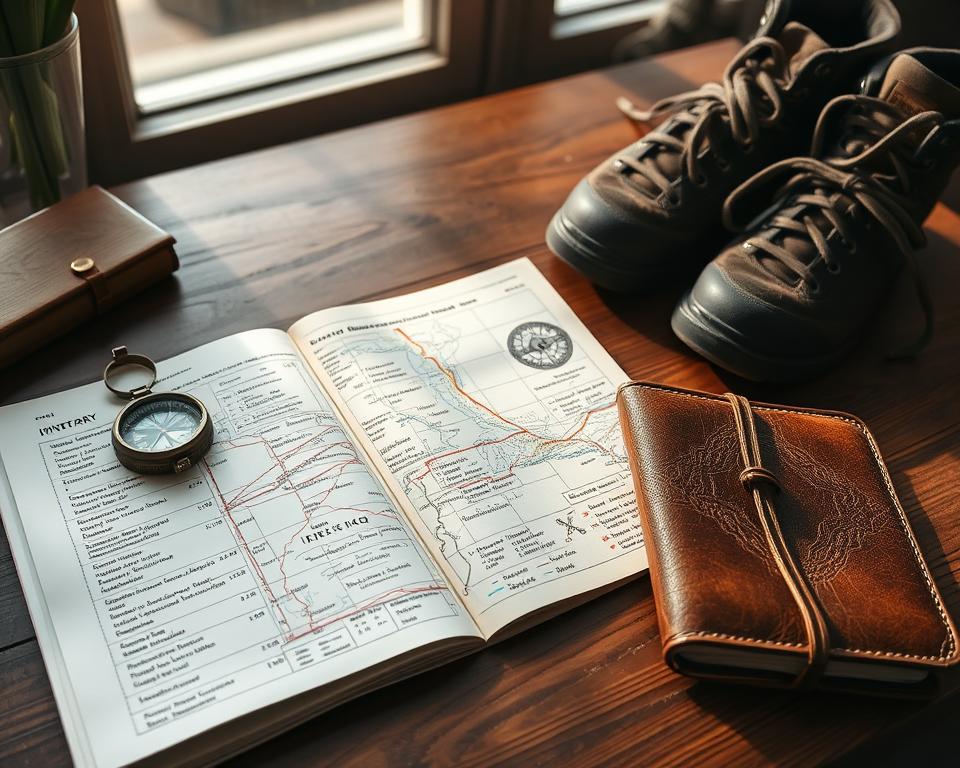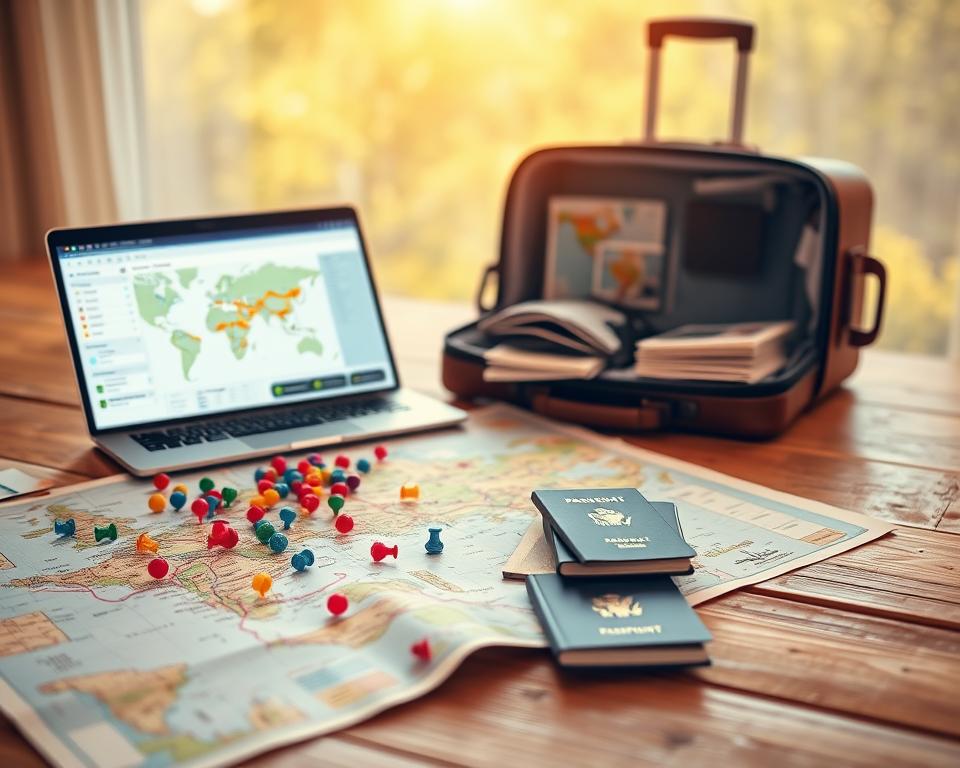Anúncios
travel planning tips can turn a tight budget into a memorable adventure. Can smart choices beat big budgets? You’ll learn how to act like a local, use modern tools, and shape a trip that fits your goals.
In 2025 costs are higher, work is more flexible, and smarter tech like eSIMs and deal alerts changes how you book. You’ll see practical examples using Going, Thrifty Traveler, and booking direct with airlines to protect changes.
This is an educational guide, not a promise of perfect results. You’ll get a clear step-by-step view of budgeting, choosing a destination and timeline, flights, stays, itineraries, research tactics, and safety essentials like IMG, SafetyWing, and NordVPN.
Expect simple ideas for day-to-day planning: one museum, one activity, one real meal. We’ll show when a hotel beats a long-term rental, how to set a regional base (Tours, Bordeaux, Toulouse), and how to use DeepL, WhatsApp, Eventbrite, Meetup, and Airbnb Experiences for local finds.
Introduction: travel planning tips for unforgettable trips on any budget
Prices and availability now swing fast, and modern tools make smart choices easier than ever. You’ll learn a practical way to save time, reduce stress, and keep your trip flexible without losing spontaneity. This guide is educational — not a guarantee — so always confirm rules with embassies and official sites.
Anúncios
Why this matters in 2025:
Why planning matters in 2025: costs, flexibility, and smarter tools
Demand shifts quickly across the world, so booking earlier helps for busy weeks while a book-as-you-go approach works for longer stays. Deal alerts like Going and Thrifty Traveler, plus eSIMs and a VPN, keep you connected and secure when you act fast.
What you’ll learn and how to use it
- Save time and stress by knowing when to lock a price and when to wait.
- Follow a simple step method that blends structure with room to explore.
- Where to do research, match a destination to your budget, and when convenience is worth a premium.
- Use itinerary apps and official tourism pages for local contacts and reliable updates.
“Scan the sections first, then return to the steps that fit where you are right now.”
Anúncios
Set your budget first to shape destinations, dates, and trip length
Begin with one number: how much money you can spend overall; divide that by the number of days and you get a practical daily allowance. This simple math helps you choose a destination, decide trip length, and set realistic expectations.
Calculate a realistic daily spend
Calculate a realistic daily spend: example frameworks for short and long trips
Start by totaling funds, then subtract fixed payments you still owe at home—loans, storage, and subscriptions. Divide the remainder by days to get a working daily budget.
- Short trips: expect higher per‑day cost for central stays and dining out.
- Long trips: plan buffers for transit or slow days that lower the average.
- Track a simple list: lodging, food, local transport, activities, and an emergency reserve.
How costs vary by region: Southeast Asia vs. Scandinavia vs. U.S. cities
As a broad example, Southeast Asia often runs much lower per day than Scandinavia or major U.S. cities, which rank among the most expensive in the world.
Savings, side hustles, and fixed expenses you’ll still carry at home
Consider boosting income before you go with remote work or a small side hustle to pad your reserve. Be honest about ongoing obligations at home so your numbers don’t overpromise.
“Set a realistic daily number and use it as a compass — not a chain.”
One clear step: pick your total, subtract fixed costs, divide by days, and then adjust by destination and style. Treat this as an educational framework and check current local prices while you research.
Time your trip: seasons, events, and crowds without breaking the bank
When you pick the right dates, you can cut costs and skip crowds without losing good weather.
Time of year affects price, availability, and how busy a place feels. Shoulder seasons often give pleasant weather, fewer people, and lower prices on flights and stays. High seasons and big festivals—Holi in India, summer school breaks, or national holidays—raise demand and lead to earlier sellouts.
- Balance: Shoulder-season days balance decent weather with better value for your budget.
- Book early: For festivals or school holidays, reserve cancellable rates and expect stricter change rules during peak weeks.
- Watch deals: Use alerts for fare drops, but compare total travel time—cheap flights can cost you long layovers.
- Check regionally: If a country has local school breaks, prices can shift by the day; scan nearby dates before you lock in.
“Treat timing as a lever—adjust dates and your destination to keep the whole trip within budget.”
Choose destinations that fit your time, money, and travel style
Focus on fit first. Match your available days and budget to a few realistic destination options before you chase a bucket-list icon.
Start a short list of places that match your time window and wallet. Group nearby destinations by geography so you spend less time in transit and more time enjoying each place.
Build a shortlist and group by geography
- Pick destinations that minimize long transfers—short hops save whole days.
- Balance one developed and one developing country to keep costs steady across your trip.
- If flights are pricey to a bucket-list spot, consider a similar vibe in a lower-cost country now and save the icon for later.
Practical filters to narrow choices
Check internal distances, transit links, and recent currency trends. Use local-language research to uncover lesser-known regions with great value.
“Stay flexible until flights line up—sometimes a nearby hub unlocks far better options.”
One more idea: If you can work remotely, slow travel in one neighborhood lowers lodging costs and lets you learn the area like a local. As you plan trip details, verify entry rules with official sources for each country.
Find better flight deals and book the smart way
A few well-timed alerts and smart searches cut through noise and help you catch real flight bargains. Start by using deal services to surface limited‑time offers, then verify prices before you commit.
Where to start
- Set alerts with Going and Thrifty Traveler to spot short-lived deals.
- Use Kayak or Skyscanner to compare dates, alternate airports, and routing options.
- When you find a good fare, check the airline site and book direct if possible to simplify later changes.
Why booking direct matters
Booking direct often makes same‑day changes, delay handling, and refunds easier. Airline apps give real‑time updates and mobile boarding passes that third‑party sites may not provide.
One-way, RTW, and overland options
Compare one‑way tickets to round‑the‑world products. RTW fares can be cheaper in some cases but are often rigid. One‑ways give you flexibility to change route and dates as your trip evolves.
For long hops, consider overland segments—trains, buses, ferries, or even repositioning cruises—when they save money and time. These can be scenic and reduce your overall flight cost.
“Always check the total trip cost, including seat fees, luggage, and transfers—not just the headline fare.”
- Try nearby dates and alternate airports for big price swings.
- Beware tight connections on separate tickets; missed legs can cost a lot.
- If status or card perks matter, include them in your decision, not just price.
- Keep screenshots of fare rules and use the airline app after booking.
For extra ideas on saving money on airfare, see ways to save on airfare.
Pick the right stay: hotel vs. rental vs. hostel for each trip type
Picking a place is more than price — it’s about convenience, comfort, and connectivity. The lodging you choose will shape daily logistics and how much you enjoy your time at the destination.
When a hotel wins
Choose a hotel for short stays of one to three days when quick check‑in, luggage storage, and on‑site services matter most.
Why hotels work: security, reception help, and built‑in food or bars save time when your days are tight.
When a rental shines
Pick a rental for longer trips when you want a kitchen, laundry, and separate spaces to relax or work.
Why a rental helps: cooking lowers daily costs and multiple rooms give privacy for calls or co‑travelers.
Hostels and hybrid options
Hostels are a budget option if you want social spaces. Look for private rooms if quiet matters.
- Confirm internet speeds with the host or front desk — “Wi‑Fi available” isn’t enough.
- Pay a bit more for a central address when it saves transit time each day.
- For work, scan photos for a desk, good lighting, and quiet rooms.
- Check reviews for noise, building quirks, and reliable washers in rentals.
- Compare total budget impact: taxes, cleaning fees, and deposits can flip the value between options.
“A slightly higher nightly rate can be worth it if you cut daily commute time or avoid expensive rides.”
One clear way: match your stay to the trip’s length and needs. Then verify internet, location, and workspace so your place supports your plans.
Choose your base of stay to unlock easy day trips
Picking a single, well-located base turns long commutes into easy morning departures and calmer evenings. A compact base helps you focus on one destination and get more out of each day.
Parking, train/bus access, and walkable essentials near your base
Decide how you’ll move each day. If you bring a car, pick a place with simple in-and-out access and affordable parking.
If you rely on public transportation, stay near the main train or bus station. Early departures and late returns matter.
Make sure cafés, bakeries, groceries, and a pharmacy are within a short walk. That keeps evenings low-stress after full days out.
Examples that work in France and why
- Tours: a classic base for Loire Valley châteaux — short drives and frequent regional trains make single-day visits easy.
- Bordeaux: central for wine towns and the Atlantic coast; good rail links reduce time on the road.
- Toulouse: a flexible hub for southern France with strong road and rail connections into countryside destinations.
“A good base keeps your mornings smooth and your evenings relaxed, even after full days out.”
Before you book, check last train or bus times and local parking rules. Line up 2–4 reachable places you can hit in under 90 minutes to get the most from each set of days on your trip.
Design a realistic itinerary you can actually enjoy
Designing a realistic itinerary starts with choosing a comfortable daily rhythm you can keep.
A simple rule: plan one museum and one other activity each day. Add time for transit and one proper sit-down meal to rest and soak in the local scene.
Why this works: you see key attractions without rushing, and you leave room for unexpected finds.

Short getaways and weeklong trips
For short escapes, focus on two or three must-do things so you don’t cram the day. In a weeklong trip, build a lighter midweek day to reset and explore a neighborhood on foot.
Work-from-anywhere schedules
If you work remotely, save most sightseeing for weekends. Use one or two half-days during the week for nearby places and evenings for local dining.
- Block anchor bookings first (flights, major tours).
- Note closing days for museums and restaurants.
- List 2–3 backup ideas near each stop to pivot quickly.
“Aim for a steady pace: one big stop, one smaller experience, and time to enjoy a real meal.”
Essential travel planning tips to start your trip right
Start your trip prep with a short research workflow that mixes print guidebooks and live local resources. That blend gives you reliable facts and the unexpected local finds that make a trip memorable.
Research smarter: guidebooks, official sites, and native searches
Begin with a current guidebook and the destination’s official tourism site to anchor facts like opening hours and entry rules. Use DeepL to search in the country’s language and reveal local events and smaller venues.
On-the-ground resources and booking basics
- Ask the tourist office and hotel concierge specific questions—what’s good this week, not just the top five attractions.
- Scan Meetup, Eventbrite, and Airbnb Experiences for classes, concerts, and neighborhood tours.
- Compare stays on Booking.com or Hostelworld, then book direct with hotels or hosts for clearer change policies.
- Use Viator for guided tours and Rentalcars.com to compare cars; check parking rules and pickup locations before you reserve.
- Buy baseline insurance (SafetyWing, Medjet, Insure My Trip, Insured Nomads) before you prepay major items.
“Keep a short tracking list of flights, transportation, and attractions you watch so you can act quickly on good deals.”
Activities and attractions: book what matters, leave room for discovery
Lock in timed-entry highlights early, but plan blocks of free time for spontaneous neighborhood finds. You often only need one or two reserved things per day to keep the trip moving while still discovering new places.
When to prebook:
- Reserve timed-entry attractions in advance when tickets sell out or lines are long.
- Choose earlier or later slots if your destination has peak-hour crowds to save time.
- If a flight arrives midday, avoid stacking tightly timed events on your first day.
Hands-on cultural experiences and local discoveries
Search in the local language for cooking classes, pottery workshops, or music nights. Native searches and local noticeboards often reveal affordable options tourists miss.
Practical ideas:
- Book one anchor activity and leave the rest of the day open for markets or street performances.
- Use platforms like Airbnb Experiences and Viator to compare prices and inclusions before you commit.
- Keep two back-pocket examples near each neighborhood in case a venue is closed.
“Let the people you meet—guides, hosts, baristas—point you toward places locals actually love.”
Consider weather and transit when scheduling outdoor things. Markets and neighborhood shows can become the highlight of a day without heavy prebooking, so balance anchors with space to explore.
Transportation at your destination: public transit, ride-hailing, and car rental
Getting around well can save you time and money, and it shapes how much you fit into each day. Start by checking city transit passes that bundle buses, metros, and trains for easy, cost‑effective moves.
For regional hops, compare fast trains and intercity buses against short-haul flights. Door‑to‑door time can make rail the better option. Use booking engines like Bookaway for coach and ferry routes.
Ride‑hailing fills gaps late at night or where connections are sparse. Watch surge pricing around events and plan a backup.
When a rental makes sense
Rent a small car for rural escapes, national parks, and places with spread‑out trailheads. Overland routes sometimes replace flights and add value.
- Compare pickup locations, fuel policies, and insurance on Rentalcars.com before you confirm.
- Plan realistic driving days with daylight and time to explore en route.
- Map parking and local street rules near your base to avoid fines.
“Always verify country‑specific road rules and required documents with official sources before you go.”
Travel tech that makes everything easier
Good tech saves you time and stress on the road. With a short, tested stack you can stay connected, secure your documents, and handle surprises without wasting a day.
Instant data, messaging, and offline maps
Add an eSIM before you fly so you have service the moment you land and can download offline maps and translation packs.
Use WhatsApp to message hosts, guides, and new friends—many businesses worldwide prefer it. Airline apps give live gate and delay alerts, so enable push notifications.
Security, backups, and practical backups
Install a VPN (NordVPN is a widely used option) to protect logins on public Wi‑Fi and ease access to banking apps abroad.
- Store passport scans, tickets, and reservation PDFs in an encrypted cloud folder and a trusted itinerary app.
- Set device PINs, enable remote wipe, and keep home and emergency numbers both in the cloud and offline.
- Test your full tech stack before departure so you don’t troubleshoot under time pressure.
“Treat technology as a support system—simple, reliable tools save time every single day.”
One final step: keep things simple. A few apps, a secure backup, and offline maps give you freedom to explore a country with fewer interruptions and more peace of mind. Carry basic insurance info with your documents in one place so you can act fast if needed.
Money, safety, and insurance: protect your trip and yourself
Smart card choices and a small emergency fund cut the practical risks that can spoil your time away from home.
Debit and credit basics: use a debit card with low or reimbursed ATM fees (Schwab is a common U.S. example) and a credit card with no foreign transaction fees. Split cards between your bags, enable card alerts, and keep one backup in a safe place.
Debit/credit tips, ATM fees, and emergency funds
Carry a modest emergency cash reserve for outages or places that don’t accept cards. Withdraw larger amounts at safe, busy ATMs to lower per‑withdrawal fees.
What insurance can cover and how to compare plans
Compare coverages early: look at trip interruption, health emergencies, evacuation, and baggage. Long‑term travelers often consider IMG or SafetyWing; add Medjet‑style evacuation if you want airlift benefits. Use marketplaces like Insure My Trip or Insured Nomads to compare specifics.
- Read exclusions: pre‑existing conditions and adventure sports vary widely.
- Save insurer contacts and policy numbers in your phone and the cloud.
- Keep this educational: review official policy documents and confirm requirements with providers and your country’s rules.
“Carry backups, read the fine print, and keep insurer contacts handy.”
Daily safety habits — stay aware, secure your bags, and use conservative ATM routines to reduce cost and fraud risk.
Travel design for different travelers: solo, groups, families, and remote workers
Match your style and companions before you go. When you decide how you want the days to feel, many small choices fall into place.
Solo travelers often benefit from central lodging and daylight arrivals. That reduces stress, eases navigation, and keeps first-day plans spontaneous.
Groups do best with a simple daily plan: one shared anchor and optional meet-ups. That lowers friction and gives people freedom to split off when they want.
Avoiding drama in groups and engaging teens with flexible days
Set expectations on budgets, meals, and transport splits before you leave home. Clear rules prevent small disagreements from growing on the road.
For families with teens, build flexible days with one hands-on activity and open time. Let a teen pick one afternoon or evening as their choice — it boosts engagement and energy.
Light packing, work setups, and staying connected on longer trips
Pack light and prefer rentals with laundry for multi-week trips. Fewer bags mean easier transfers and lower rental car size needs.
If you work remotely, verify internet speeds, book quiet hours, and keep a coworking backup. Use a WhatsApp group and pinned locations so people stay coordinated without repeated calls.
“Agreeing on a few basics makes days smoother and keeps the focus on enjoying your vacation together.”
- Choose a car that fits luggage and limit long drives to preserve morale.
- Share budgets and meal styles up front to avoid surprises.
- If schooling on the road, slot study blocks into your weekly rhythm and confirm country requirements before you go.
Plan responsibly and travel with purpose
Start your trip with an intent to leave a place better than you found it. Small choices—where you eat, how you move, and who you hire—shape the lives of the people you meet and the world you visit.
Respect local culture, support social enterprises, and pace to prevent burnout
Learn a few local phrases and read basic etiquette before you arrive. That small effort opens doors and shows respect.
- Support small shops, markets, and social enterprises to keep money in the community.
- Choose activities that benefit locals—workshops, neighborhood guides, and community-run sights.
- Pace your days: rest days are part of smart planning to avoid fatigue and stay present.
- Use public transport when safe; it often deepens your sense of place and helps people who rely on daily ridership.
- Before volunteering or entering protected areas, do research and confirm permits with official sources.
“Responsible choices add meaning to your journey and help sustain the places you love to visit.”
One small rule: travel with curiosity and humility. When you act thoughtfully, your trip becomes richer for you and for the country and people you meet. These ideas let travelers leave a positive footprint.
Conclusion
Finish with a clear, calm checklist so your last steps are simple and useful.
Keep your itinerary practical: one museum, one activity, and one real meal each day to pace your time and energy.
Book anchors first and then leave flexible space. Use deal alerts, book direct where it helps, and add an eSIM and WhatsApp for easy local contact.
Before you finalize: verify rules with embassies or official tourism sites and consider insurance for major prepaid flights or stays.
Make a short list of must-dos, pack a backup card and offline maps, and protect buffers between things so days feel full but not rushed. Use this step-by-step structure to plan trip details confidently and responsibly.



